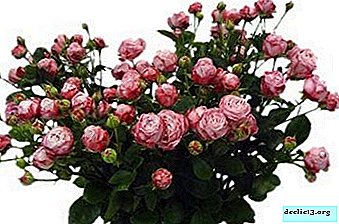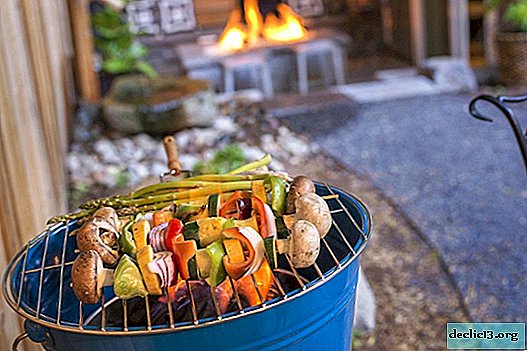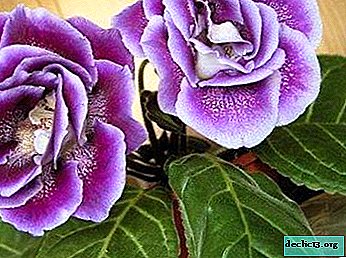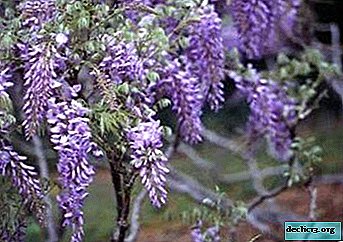All about the winter round black radish: how it differs from other species, when and how to plant other nuances
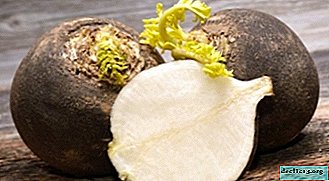
Radish is not just a vegetable, but a storehouse of vitamins, minerals and minerals that can protect your body from colds. And the winter black round radish is superior in utility to the other representatives of its kind.
The article tells in detail what kind of root crop it is, what its value and shortcomings are, what are the differences from other “relatives”, what are they used for, as well as planting, care and harvesting, including the fight against diseases and pests.
Detailed description and description
- Appearance: the vegetable has a rounded flat shape, reaches 12 cm in diameter. The surface is smooth, sometimes rough. The root peel is thin, black. The pulp is tender, juicy, white. The radish weighs from 250 - 500 g.
- Sowing time: sow this variety in June-July. Planting before June 20 does not make sense, prematureness will make the vegetable coarse and cracking.
- Productivity: radish has a high yield. From 1 ha, on average, 35–45 tons of root crops are harvested (3.5–4 kg per 1 sq. M).
- Where it is recommended to grow: in the open ground, because the vegetable is frost-resistant and unpretentious. Thanks to these properties, it is not necessary to grow seedlings at home.
Reference! You can not sow after cabbage and radishes, a high probability of infection in the ground.
If you have a heated greenhouse and a desire to grow radish year-round, then you can plant a vegetable in any season and there.
- Disease resistance: the plant is resistant to diseases such as bloom - flowering of biennial plants in the first year of life. Still there is resistance to fungal diseases.
- Ripening period: winter round black radish belongs to mid-season root crops. The period from planting to ripeness of 70-93 days.
- What types of soil prefers: Land for planting should be loose, light, slightly acidic, nutritious.
Breeding History
Radish "Winter Round Black" is a variety developed by the All-Russian Research Institute of Selection and Seed Production of Vegetable Crops. It is allowed for cultivation throughout the territory of the Russian Federation (except for the Northern region) since 1950. It is recommended for garden plots, home gardens and farms.
In ancient Russia, a vegetable was considered a useful and healing product.
There are early, mid-ripening and late subspecies of culture.
What is the difference from the rest of the species?
 Radish may be different, but each species has its own varieties. So it is with black.
Radish may be different, but each species has its own varieties. So it is with black.
Black round winter radish. Mid-season grade. The vegetable contains many essential oils, vitamins and minerals. The peel is smooth, black. The pulp is white, dense, pungent, with a bitter taste, which is considered the most "right" among the brethren. It has good keeping quality relative to other varieties. High productivity and immunity in diseases.
Items for which the difference is made:
- ripening time;
- useful properties and content of vitamin and essential oils;
- taste and color;
- root crop form;
- productivity;
- keeping quality.
Advantages and disadvantages
Important! Due to its high glycoside content, it has antimicrobial properties.Used in folk medicine, but not denied in traditional. The root crop contains a large amount:
- vitamins (a lot of vit. C, B1, retinol, B9, K);
- minerals (sodium, potassium, calcium, magnesium, phosphorus and iron salts);
- essential oils (give a pungent taste with bitterness);
- volatile (cause antimicrobial effect);
- glycosides.
 All these components help to fight colds and viral diseases, maintain immunity and make up for the lack of minerals in the human body.
All these components help to fight colds and viral diseases, maintain immunity and make up for the lack of minerals in the human body.
Black radish can not be used for diseases of the stomach - ulcers, gastritis, with high acidity, for diseases of the cardiovascular system and small intestine.
The variety is unpretentious in care, but loves moisture and open sunny places. It is also resistant to disease. The culture is frost-resistant and suitable for cultivation in Siberia.
Disadvantages:
- crop rotation must be observed (if planted after a species of cruciferous family, soil infection is possible);
- intolerance of radish juice by people with diseases of the stomach;
- frequent watering (drought will reduce yield).
Why and where is it used?
In traditional medicine:
- Compresses are made from the gruel of the vegetable for pneumonia and bronchitis (throat).
- Radish juice, infused with honey, is used against sore throats and coughs.
- Fresh juice is used as a choleretic agent.
- To stop the growth of malignant tumors.
- Sulfuric essential oils, which are in black radish, well stimulate appetite and stimulate digestion.
- Used in the treatment of rheumatic pain.
In cosmetology: radish oil extract is used in the composition of nourishing masks for the skin, body creams, and hair serums. It is used as an anti-inflammatory agent, eliminates puffiness, fights pigment spots and freckles.
Important! Due to the presence of a large amount of essential oils in the composition of the root crop, it is contraindicated during pregnancy.Step-by-step instructions for landing and care
Vegetable likes open, well-warmed places and frequent watering. Before planting, the soil must be dug up and fertilized with compost or peat. On the dug up earth, it is necessary to form furrows (at a distance of 30 cm) and holes (the distance between future plants should be 15-20 cm).
When to plant, how to plant and care?
 The time of planting seeds in open ground in late June and early July, when the ground warms up enough. The place is selected taking into account crop rotation. You can plant after:
The time of planting seeds in open ground in late June and early July, when the ground warms up enough. The place is selected taking into account crop rotation. You can plant after:
- carrots;
- cucumbers
- Tomatoes
- potatoes.
To prevent infection of seeds with vascular bacteriosis, you need to warm them in the sun at a temperature of 45 degrees for about 30 minutes. When planting, seeds are placed in moist soil to a depth of 2-3 cm. Several seeds are laid in one recess. After the appearance of the sprouts, you need to choose the strongest and largest, remove the rest. Thinning is repeated after several weeks.
Sowing should be systematically watered and fertilized with ash for disinfection.
The soil must be loosened after each watering and fertilized every 2 weeks. Organic fertilizers can not be used!
Mineral fertilizing:
- superphosphate;
- potassium;
- saltpeter.
Harvesting and storage
Harvest vegetables before frost. When assembling, the green part of the plant is carefully cut, and the root crop is dried. The plant must be stored in wooden pallets or in dark bags in the cellar. In such containers, ventilation holes must be made so that the radish does not rot. Storage temperature: +2, +3 degrees. Humidity: 80%.
We offer you to watch a video about planting, care, collecting radish and its storage:
Diseases and Pests
 Disease
Disease
- Kila - A disease caused by pseudo-fungi. First, growths appear on the roots, and then the plant dries.
- Powdery mildew - white coating on the tops. Because of this disease, the leaves die.
- Root rot - fungal disease. In a sick plant, the stem first darkens, and then the root system begins to hurt.
Such diseases are noted on neglected landings.
Pests:
- Cruciferous midges and carrot flies are insects that spoil the outer cover of the root crop. Through damage, spores of fungi and bacteria can penetrate.
- Slugs, aphids, rapeseed and cabbage leaf beetles - spoil the leaves of the plant.
Prevention of various problems
- To prevent the occurrence of pests, wells with radish should be sprinkled with wood ash.
- So that scoops, bugs and other insects do not appear, it is important to regularly and timely remove weeds from the beds.
- Various biological products will help from aphids, which will not affect the quality of the root crop.
- To protect against weeds and pathogenic bacteria, it is necessary to mulch the beds with sawdust, straw, leaves.
Similar varieties
The main varieties and their similarities:
- Murzilka. Late variety used for winter consumption. The vegetable is large and round, the skin is dark gray - black. The inside has a white color and a slightly island flavor. Can be stored until spring in cool, dark places.
- Draft. Late ripe root crop. The shape is round. The peel is black, rough. The flesh is of a sweet, sweet, spicy taste. The root crop has an attractive appearance and is stored for a long time.
- The night. Mid-season variety, intended for industrial cultivation. The shape is round, color is black. Weight up to 350 kg. The pulp is white, crispy, slightly spicy taste. The vegetable is stored for a long time. Productivity 3,5-4 kg / 1 sq. m
- Black woman. Winter mid-season variety intended for cultivation by private traders. The root crop reaches a weight of 300 g, has a black peel and creamy pulp with a mild flavor. The form of a black woman is round and slightly elongated.
- Black dragon. Matures within 50-65 days. It has dietary properties and a mild, mild taste. The vegetable has a long cylindrical shape and an average weight of 150-200 g. The appearance is black, and the flesh has a white color and a dense structure.
- Healer. Ripens 75-85 days (mid-season). It has a round or oval shape. Outside is black, inside is white. The flesh is crispy, not too sharp. Productivity up to 4.5 kg / 1 sq. m. Consists during the winter.
- The Queen of Spades. Mid-season grade. The root crop has the shape of a cylinder. Weight 350-500 g. The skin is black, dense, and the flesh is light - slightly spicy taste. The variety is resistant to the formation of arrows, minimal care is required. Productivity is high - up to 6 kg / 1 sq. m
Most of the species are mid-season, have a long shelf life, high productivity and marketable "appearance". Black winter round radish is one of the most healthy vegetables available at any time of the year, due to its ability to be stored for a long time. Now you know how to plant and collect it, what useful properties it has, and what are the disadvantages. Good luck in planting and pest control!

